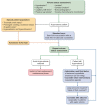Fluids in the ICU: which is the right one?
- PMID: 36170962
- PMCID: PMC10310506
- DOI: 10.1093/ndt/gfac279
Fluids in the ICU: which is the right one?
Abstract
The administration of fluids is one of the most common interventions in the intensive care unit. The effects and side effects of intravenous fluids depend on the amount administered and their specific composition. Intravenous fluid solutions are either considered crystalloids (for example 0.9% saline, lactated Ringer's solution) or colloids (artificial colloids such as gelatins, and albumin). This narrative review summarizes the physiological principles of fluid therapy and reviews the most important studies on crystalloids, artificial colloids and albumin in the context of critically ill patients.
Keywords: albumin; colloids; critically ill; crystalloids, intravenous fluids.
© The Author(s) 2022. Published by Oxford University Press on behalf of the ERA.
Conflict of interest statement
T.M. declares no competing interests. A.D.S. is a consultant for Edwards Lifesciences, FAST BioMedical, Fresenius, Astellas and AM Pharma. C.J.W. is a consultant for CSL Behring and has received fees for speaking from CSL Behring and Biotest. M.J. has received honoraria and/or research support from Baxter Healthcare Corp., AM-Pharma, CLS Behring, Fresenius, Gilead and Novartis.
Figures





